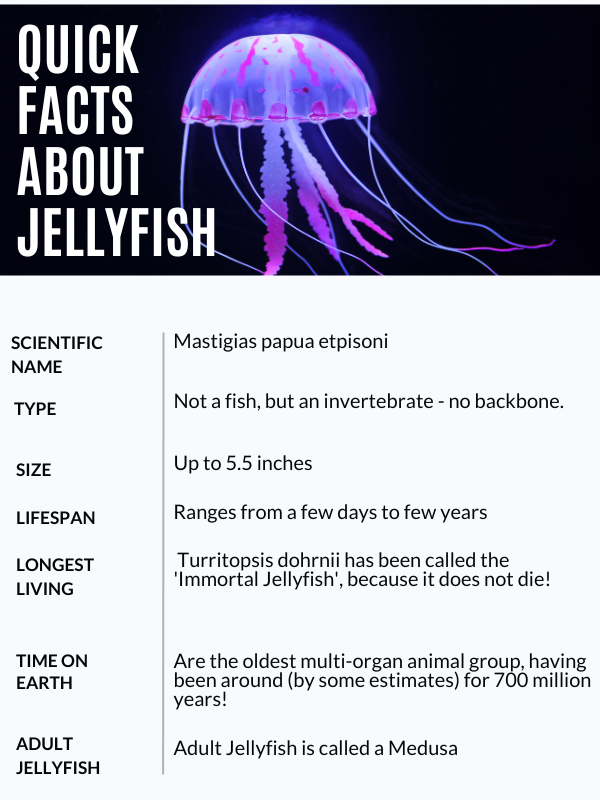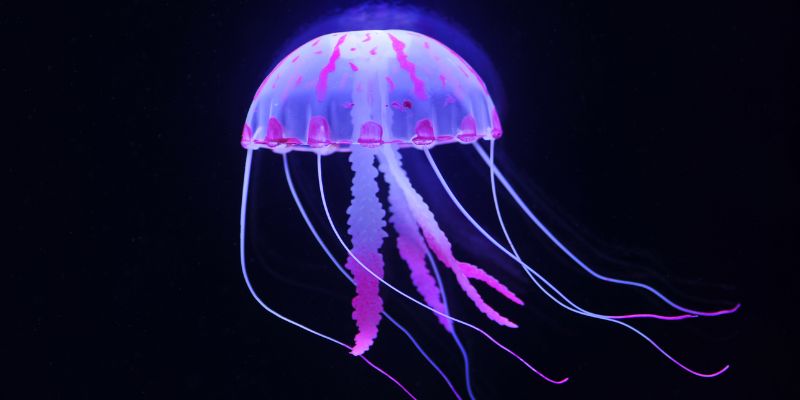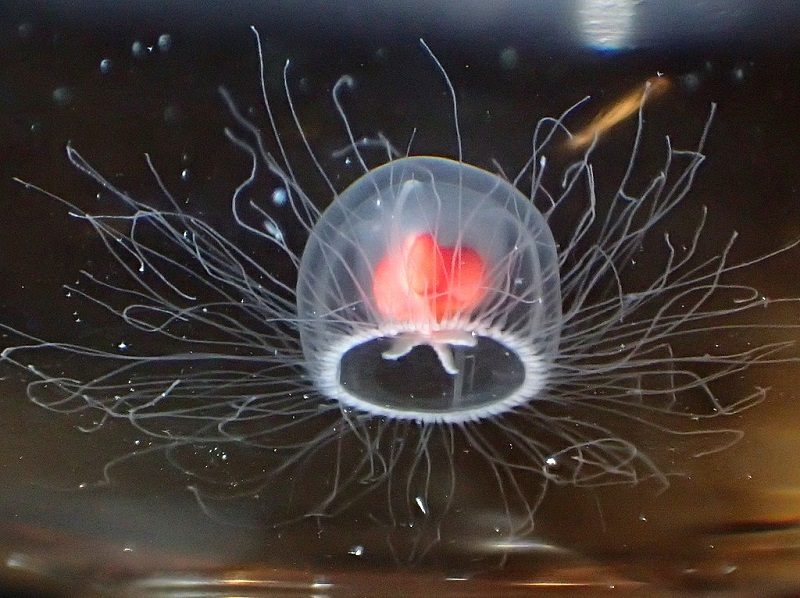Top Amazing Fun Facts About Jellyfish
Written by Serene Joshua, contributing writer
Jellyfish are not fish, but are invertebrates, which means unlike fish these animals don’t have a backbone, and this lack of a backbone helps them to float around in the oceans.
Written by Serene Joshua, contributing writer
Let’s begin with some fun facts about jellyfish – they are said to be the oldest multi-organ animal group, having been around (by some estimates) for 700 million years!
Here’s what you need to know first – even though they are called Jellyfish, they are not fish – they’re invertebrates (know more a little below)
Here’s a super interesting fun fact about jellyfish.
A species name Turritopsis dohrnii has been called the ‘Immortal Jellyfish’, because it does not die!
A quick look…

We’ll discover lots of interesting facts about jellyfish in this article, including things like, what do jellyfish eat, where they live, facts about jellyfish stings (they can really sting hard!). Also, scroll down to the answer of the question – do jellyfish have brains or hearts?!
So read on for fun facts about jellyfish for kids!
Did you know that they have been to space or that they have no brains?
Here we go….
What is a Jellyfish?

Like mentioned above, these creatures are not exactly fish.
They are known as invertebrates, which means unlike fish these animals don’t have a backbone, and this lack of a backbone helps them to float around in a pulsating way in the oceans.
They are small creatures. A typical size of a jellyfish is between half an inch to 40 inches, depending on the type and where it comes from.
Some jellyfish are clear – it you can almost see right through them. Others are different – they can be pink, yellow, purple or blue. Some even glow!
The moon jellyfish (Aurelia aurita) is the most common type of jellyfish
Where are jellyfish found?

They are in all oceans in the world, as they travel easily with water currents.
What do Jellyfish eat?
Jellyfish eat small plants, fish, crabs and shrimps. They sting their prey with their long noodle-like tentacles.
How long do Jellyfish live?

Depending on the species they can live from a few days to decades.
Let’s quickly look at the life cycle of a jellyfish to understand how long jellyfish live and how they begin life. These facts about jellyfish life cycles is important to know to understand them better.
Jellyfish basically take on two different body forms, or phases so to speak, in their life cycles – medusa and polyps.
The medusa is an adult jellyfish and a polyp is a phase where the jellyfish is attached to the ground (explained below).
This is how the lifecycle of a jellyfish works (in a nutshell).
The medusa, being the reproductive stage, produce eggs and these eggs develop into free-swimming larvae.
A larva, in certain species, is a in-between stage of life that’s in between an egg and an adult form.
This larvae then sink to the bottom of the ocean and attach themselves to the sea or ocean bed or some coral reefs.
They then develop into, what are called, ‘polyps’ – which grow and then swim way from the seabed and float into the ocean – they turn into adults, which are ‘medusas’.
It’s hard to determine how long jellyfish live, because they have complex life cycles. They are said to live anywhere from one to three years. There are some species that can live from a few days to years and decades.
As mentioned above, the ‘Immortal Jellyfish’ (Turritopsis dohrnii) is said to live forever!
Read on for more, as we bring you 20 facts about jellyfish!
Top 20 fun facts about jellyfish for kids

From what jellyfish eat and where they live to the whether they have brains of hearts – here are fun facts about jellyfish to know!
1. Jellyfish are mostly just water

Ok, now this is a very important and most well-known fun fact about jellyfish – they are made up of 95 per cent water! This means that they are only 5 per cent solid. This is a big factor as to why they move so easily and fluidly.
2. Jellyfish don’t have brains

Although they don’t have a brain, they have nerves at the end of their tentacles that help them know touch, temperature etc., and also have automatic and reflexive responses.
3. Jellyfish don’t have heart or blood either

It’s true. These animals are different from most others. They don’t have hearts or blood. They are basically made up of three layers – the epidermis, which is the outer layer; the mesoglea, which is the middle layer – this is what is the jelly-like, elastic substance, and then there’s the gastrodermis, which is the inner layer.
Now you know the answer to the question – do jellyfish have brains or hearts?
4. Jellyfish can be clones

If you slice a jellyfish in two it won’t die, instead, they regenerate and produce new organs from which two organisms come about
5. Jellyfish have been to space!
In 1991, 2000 jellyfish called Moonfish were sent to space by NASA, to test how they would react to different gravitational pulls.
In space, these jellyfish reproduced and there were a total of 60,000 jellyfish in space! Unfortunately, they could not survive the conditions on earth once they were back.
6. Jellyfish can glow in the dark

Some Jellyfish emit blue or green light and these are called bioluminescent. This glow comes from a luminescent ink that they have and use it in order to distract predators, to warn other organisms that they have occupied a space and sometimes to attract predators that will attack each other! Pretty smart for a creature with no brain, right?
7. Jellyfish are older than dinosaurs

Jellyfish have existed for over 500 million years, which is 250 million years before the first dinosaurs, which means they are much older than dinosaurs, making them one of the oldest living creatures on earth!
8. Jellyfish aren’t really fish

As mentioned before jellyfish are actually invertebrates which means that they don’t have a backbone and almost all fish have backbones which is an important feature of a fish’s anatomy.
9. Jellyfish are doing well despite climate change

Climate change is a harmful event that is causing many species and animals to die out due to the heating of water, but in the past 20 years, there has been an increase in the jellyfish population. This shows that they are able to adapt to these conditions.
10. Jellyfish were named pretty early on

Although they are not fish, these creatures got their name due to their jelly-like structure and the word has been in use since 1796.
11. Jellyfish sting can be dangerous

Around the world, about 150 million people are stung by jellyfish each year! But the thing to know is that jellyfish don’t attack people on purpose. They sting when people touch them! Jellyfish stings can be painful and even cause serious harm!
12. Jellyfish eat and defecate (clear) through the same opening!

Here’s an icky but interesting fact, jellyfish excrete waste through the same opening they use to consume food because they lack an anus. This opening is located at the centre of their bodies.
13. Dead Jellyfish can still sting

Remember how we talked about the fact that jellyfish can still live when cut into two? Well, this same mechanism applies to their stingers as well. They emit toxins as their cells are still functioning long after they die.
14. The Box Jellyfish is deadly – its sting can kill

We know that jellyfish are deadly, but the Box Jellyfish is the most poisonous marine animal! Did you know this fact about jellyfish?
They have tiny darts in their body, full of poison. The Australian Box Jellyfish is the deadliest in this category and have tentacles up to 10 feet long!
15. A museum exists for Jellyfish
If you’re into weird museums, this one might be just up your alley. In Kyiv, Ukraine there is a museum located underground with many tanks filled with different Jellyfish species.
16. National Jellyfish Day

International Jellyfish Day is celebrated on 3rd November each year and encourages people to learn more information about jellyfish.
17. Some Jellyfish never die!

Image Source: Tony Wills, via Wikimedia Commons
The Turritopsis nutricula jellyfish is also called the Immortal Jellyfish as they replace their cells with new cells when they are threatened so they never actually die.
18. A group of jellyfish have an interesting name

You may have learnt in school about how different animals have different collective names when they are together like swarms or herds. The jellyfish does too! A group of jellyfish is called a “bloom” or a “smack”
19. Jellyfish can get really big

One species of Jellyfish called Lion’s Mane Jellyfish can grow up to 6 feet long! It has thousands of tentacles that are kept in 8 clusters
20. Jellyfish are antisocial

Although there are names for jellyfish clusters, they rarely travel together. When you do find them in blooms or smacks this is probably because they are following the same current or food source
Where are Jellyfish found?

Now that we’ve covered fun facts about jellyfish you might ask “Where are jellyfish found?”
Well, as mentioned before they are found in all oceans, in shallow waters and the deep seas around the world as they easily adapt to any environment.
However, some species like the Lion’s Mane Jellyfish prefer colder waters whereas others prefer tropical waters and mostly stay near the surface of the water.
In India, you can find them on the beaches of Goa, Puri, Chennai and Mumbai.
Although they are found almost anywhere, there are five islands that they are mostly found in and these are the
1. Palau Rock Islands in the pacific oceans which have clear waters and rocky bottoms
2. Moorea Islands ear Tahiti which don’t have much of a human population so jellyfish thrive here
3. Okinowa Beach, Japan has a lot of Box jellyfish here so beware!
4. Jamaica’s town of Negril has a lot of beaches and the Negril reef have some jellyfish as well
5. St. Vincent and Grenadines Island have coral reefs that are home to many small fish which provide delicious food for Jellyfish
What makes Jellyfish unique?

Well for starters, most sea creatures are vertebrates, which means they have a backbone. However, Jellyfish are little blobs that float around the ocean with a balloon-shaped bodies.
They are also quite deadly; in fact, they injure more people than sharks do! Making them one of the scariest sea creatures.
Unlike most fish, there are also many microscopic jellyfish. As of now, about 2000 Jellyfish species have been discovered but scientists estimate that the actual number of Jellyfish species could be over 300,000!
They are also carnivores unlike most fish and when they have access to a lot of food they reproduce really fast and increase in numbers very quickly.
Jellyfish also have a large number of predators like ocean sunfish, turtles, whale sharks, crabs and sharks.
Now that you have learnt information and fun facts about jellyfish just be sure that next time you’re on a beach, you don’t get stung!
You May Also Like:
How Did Dinosaurs Disappear?
Fun Facts About Cats
Fun Facts About Kangaroos

Better Your Child’s G.K. In 3 Minutes – Get This Free Newsletter
Get fun facts, simple and easy news, quizzes, and lots of other interesting things to read in your mailbox – for free! It’s what we call GK-on-the-go!
I Kid You Not now has a large readership across India and also parts of the world. If you want to write for us, you can submit your story here. You can also apply to become a news anchor. Apply here



Comments